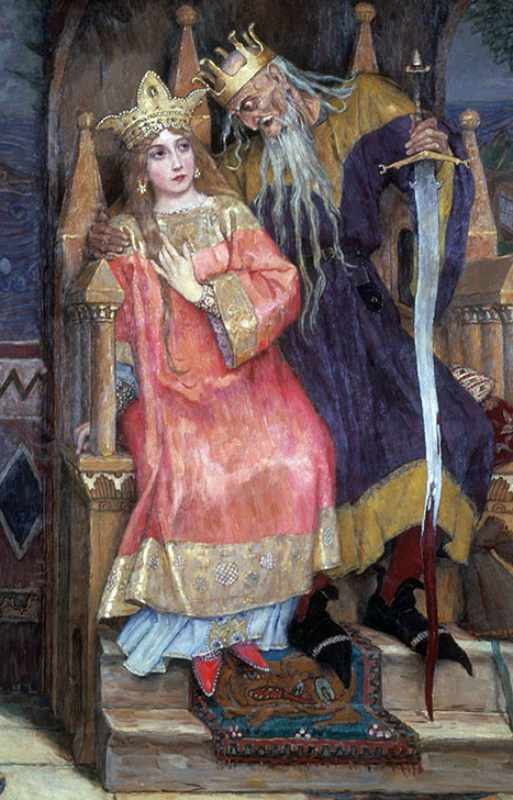Koschei (Russian: Коще́й, tr. Koshchey, IPA: [kɐˈɕːej]), often given the epithet “the Immortal”, or “the Deathless” (Russian: Коще́й Бессме́ртный), is an archetypal male antagonist in Russian folklore. The most common feature of tales involving Koschei is a spell which prevents him from being killed. He hides his soul inside nested objects to protect it. For example, the soul (or in the tales, it is usually called “death”) may be hidden in the needle that is hidden inside the egg, the egg is in the duck, the duck is in the hare, the hare is in the chest, the chest is buried or chained up on a far island. Usually he takes the role of a malevolent rival father figure, who competes for (or entraps) a male hero’s love interest. The origin of the tales is unknown. The archetype may contain elements derived from the 12th-century pagan Cuman-Kipchak (Polovtsian) leader Khan Konchak, who is recorded in The Tale of Igor’s Campaign. In other tales, Koschei can cast a sleep spell that can be broken by playing an enchanted gusli. Depending on the tale he has different characteristics: he may ride a three- or seven-legged horse; may have tusks or fangs; and may possess a variety of different magic objects (like cloaks and rings) that a hero is sent to obtain; or he may have other magic powers. In one tale he has eyelids so heavy he requires servants to lift them. Psychologically, Koschei can represent an initially benevolent, but later malevolent, father (to a bride) figure. The parallel female figure, Baba Yaga, as a rule does not appear in the same tale with Koschei, though exceptions exists where both appear together as a married couple, or as siblings. Sometimes, Baba Yaga, as an old woman figure appears in tales along with Koschei as his mother or aunt.
| Alias Koschei the Deathless |
| Real Names/Alt Names Tsar Koschei, The Immortal |
| Characteristics Villain, Magician, Politician, Myths & Legends, Giant, Flight, Immortal, Magic Caster, Medieval Age, Russian |
| Creators/Key Contributors Unknown |
| First Appearance Russian folklore |
| First Publisher ○ |
| Appearance List Russian Fairy Tales by Alexander Afanasyev (1855–1863), Tales and Legends from the Land of the Tzar (1890), The Red Fairy Book (1890) by Andrew Lang [Internet Archive], Russian Folk-Tales trans. by Leonard Magnus from Afanasyev (1916) |
| Sample Read Russian Folk-Tales [Internet Archive] |
| Description Koschei (Russian: Коще́й, tr. Koshchey, IPA: [kɐˈɕːej]), often given the epithet “the Immortal”, or “the Deathless” (Russian: Коще́й Бессме́ртный), is an archetypal male antagonist in Russian folklore. The most common feature of tales involving Koschei is a spell which prevents him from being killed. He hides his soul inside nested objects to protect it. For example, the soul (or in the tales, it is usually called “death”) may be hidden in the needle that is hidden inside the egg, the egg is in the duck, the duck is in the hare, the hare is in the chest, the chest is buried or chained up on a far island. Usually he takes the role of a malevolent rival father figure, who competes for (or entraps) a male hero’s love interest. The origin of the tales is unknown. The archetype may contain elements derived from the 12th-century pagan Cuman-Kipchak (Polovtsian) leader Khan Konchak, who is recorded in The Tale of Igor’s Campaign. In other tales, Koschei can cast a sleep spell that can be broken by playing an enchanted gusli. Depending on the tale he has different characteristics: he may ride a three- or seven-legged horse; may have tusks or fangs; and may possess a variety of different magic objects (like cloaks and rings) that a hero is sent to obtain; or he may have other magic powers. In one tale he has eyelids so heavy he requires servants to lift them. Psychologically, Koschei can represent an initially benevolent, but later malevolent, father (to a bride) figure. The parallel female figure, Baba Yaga, as a rule does not appear in the same tale with Koschei, though exceptions exists where both appear together as a married couple, or as siblings. Sometimes, Baba Yaga, as an old woman figure appears in tales along with Koschei as his mother or aunt. |
| Source Koschei – Wikipedia |



